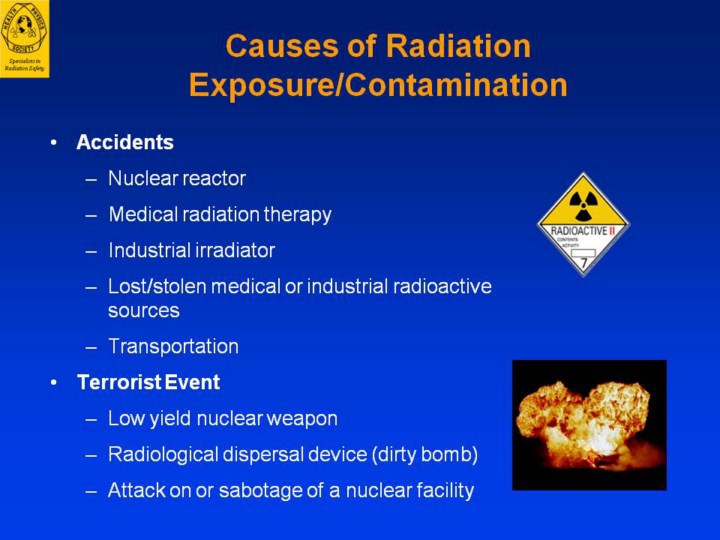| front |1 |2 |3 |4 |5 |6 |7 |8 |9 |10 |11 |12 |13 |14 |15 |16 |17 |18 |19 |20 |21 |22 |23 |24 |25 |26 |27 |28 |29 |30 |31 |32 |33 |34 |35 |36 |37 |38 |39 |40 |41 |42 |43 |review |
 |
Causes of Radiation Exposure and Contamination
•Accidents
-
There
are several settings or scenarios in which radiation accidents may
occur: nuclear reactor accidents; medical radiation therapy accidents or
errors in treatment dose; accidental overexposures from industrial
irradiators; lost, stolen or misused medical or industrial radioactive
sources; and accidents during the transportation of radioactive
material.
•Terrorist
Use of Nuclear Materials
- The use of radioactive materials in an RDD or a nuclear weapon by a
terrorist is a remote but plausible threat. The medical consequences
depend on the type of device used in a terrorist event. An attack on or
sabotage of a nuclear facility, such as an irradiation facility or a
nuclear power plant, could result in the release of very large amounts
of radioactive material.
•
Radiological Dispersal Device (RDD) - A RDD disperses radioactive material for the purpose of terrorism. A RDD that uses a conventional explosive (e.g., TNT or a plastic explosive) to disperse the radioactive material is called a “dirty bomb”. A dirty bomb is NOT an atomic bomb. The initial explosion may kill or injure those closest to the bomb, while the radioactive material remains to expose and contaminate survivors and emergency responders.
•
Low Yield Nuclear Weapon - A low yield nuclear weapon or partial failure of a high yield weapon could cause a low yield nuclear detonation. For example, if one considers the consequences of a 0.1 kiloton yield nuclear detonation (less than 1/100 the size of the weapon used on Hiroshima), then the following would occur within one minute surrounding ground zero. The effects listed below do not take into account that multiple injuries caused by the interaction of the various types of injury will increase the probability of fatality. (NCRP Report No. 138) - The range for 50% mortality from trauma from the blast is approximately 150 yards. - The range for 50% mortality from thermal burns is approximately 220 yards. - The range for 400 rad from gamma and neutron radiation would be approximately 1/3 mile. - The range for 400 rad in the first hour from radioactive fallout would be almost 2 miles in the downwind direction. - As the size of the weapon increases, the effects encompass a greater distance. This will result in the release of widespread contamination and substantial air blast and heat. |